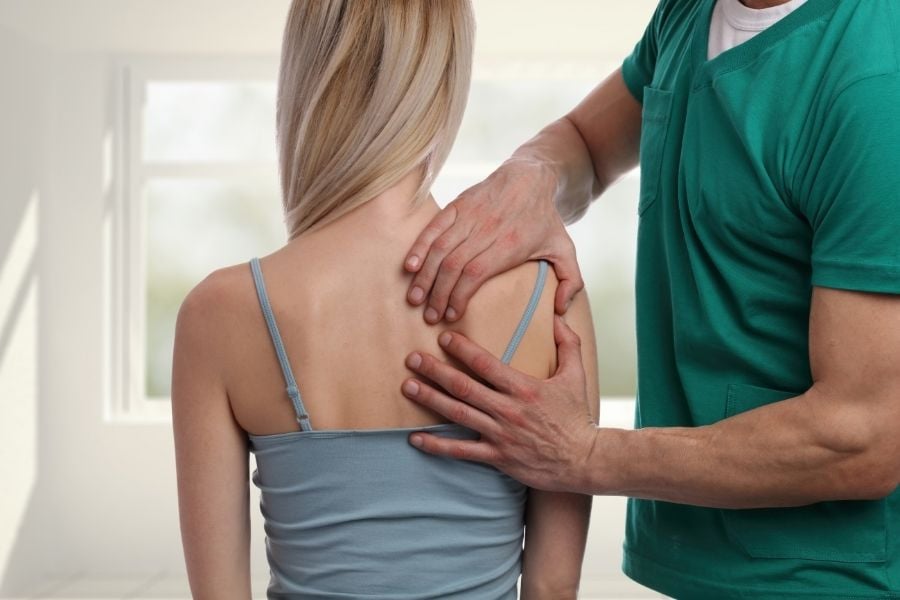Sometimes, our bodies need a push in the right direction. We all want to move freely, easily, and without pain, but it’s easier said than done. Whether you have a chronic injury or muscle tightness from working at home, visiting a manual practitioner can do wonders for you and your body.
If you’re new to the world of Rehab, it can feel difficult to decide what type of treatment you need. Practitioners have a wide range of specialties. How do you make the right choice?
One of our goals at HealthOne is to be an educational resource for you. We're here to provide real, factual information about health and wellness topics with the help of our very own practitioners.
The world of Rehab is a big one, so today we’re focusing on two forms of manual therapy: physiotherapy and massage therapy. We’ll cover all the basics including what they are, what happens during an appointment, the cost, and the key signs you might need treatment.
Keep reading to hear what our physiotherapist, Alex, and our Registered Massage Therapist, Gurdev, had to say.
What Is Physiotherapy?
Physiotherapy is a hands-on, patient-centred approach to healthcare that promotes the recovery of your injury, illness, or disability. According to Alex, there are two main categories of patients he works with.
“One is they have a very acute injury,” he says. “Let’s say a sports injury, where they twist their ankle or injure a ligament in their knee. They experience some sort of pain and their function is limited.”
In this case, physiotherapy would be used to assess the injury, figure out how good or bad it is, determine if they need to see a doctor and whether they need x-rays or an ultrasound.
“Essentially, we’d come up with a program to help them get back to 100% depending on what their goal is – whether it’s to return to sports, or be able to walk or run more,” he explains.
The second category is people who notice aches and pains creeping up. Usually, the pain is something they weren’t experiencing months ago and isn’t resolving on its own.
In both cases, a physiotherapist would help by assessing and diagnosing the injury or pain. From there, they’d come up with a treatment plan to help the patient work towards their goals.

What Happens During a Physiotherapy Appointment?
The first step is an initial assessment. “I always sit down with the client and figure out why they’re here and what they’re hoping to get out of their session,” Alex shares.
Understanding the patient’s goals is important because it helps him determine the best treatment approach. An assessment is often very movement-based to give the practitioner a better idea of your abilities.
“Essentially, we’re trying to figure out that person’s posture, how they move, and if we can get them moving better. That typically involves assessing their strength, flexibility and balance based on how they do with certain tests.”
Oftentimes, your treatment approach will include a customized exercise program. This might involve more gentle movements, like stretches, or more strength-based moves with added resistance.
Your treatment might also include hands-on therapy. “Depending on the practitioner, that could involve acupuncture, electroacupuncture, deep tissue massage, or even adjustments,” Alex says.
Every person’s body is unique, so a physiotherapist will come up with the best treatment for your specific needs. They will also review how long it should take and how often you need to visit them.
According to Alex, acute injuries take around 12 weeks to heal. He’ll typically see patients once or twice a week depending on the severity of their case. For someone with chronic issues, on the other hand, treatment could be every 2 weeks to provide maintenance on an ongoing basis. The ultimate goal at the end of the day, regardless of your situation, is to get you moving better.
How Much Does Physiotherapy Cost?
At HealthOne, we offer free consultations so you can speak with a physiotherapist before booking your first appointment. Once you’ve decided they're the right fit for you, your initial assessment will cost $130 and each 30-minute follow up will cost $85.
Services are covered by OHIP if you meet specific criteria outlined by the Ontario Community Physiotherapy Clinic Program. We also accept most major insurance providers – speak with a member of our Rehab team about your coverage options!
Key Signs You Should Consider Physiotherapy
Now that we’ve covered the basics of physiotherapy, let’s dive into the main signs you should consider getting treatment.
1. You have a new injury.
Once you have an injury, there’s no need to wait. You should consider seeing a physio as soon as possible to increase your chances of a successful recovery.
“9 times out of 10, people come in after an injury too late,” Alex says. “They wait a couple of months, it doesn’t get better, then at that point, we have to undo a lot of misuses because people get weaker and stiffer.”
So, be proactive and seek help in the unfortunate case that you get injured. Waiting will only prolong the process!

2. You have a chronic injury or persistent pain.
If your injury or pain hasn’t gone away yet, you should visit a physiotherapist. "Something is likely causing it that hasn’t been addressed yet, and we’re the perfect person to do that,” he explains.
Physiotherapists work with the muscles, tendons, ligaments, joints, bones, and have training in neurological issues, too. No pain is off-limits. What a lot of people don’t know is that physiotherapists can also treat Bell’s Palsy, Cerebral Palsy, strokes, and even help people with cardiovascular and lung issues. If you’re suffering from pain–especially if it’s affecting your quality of life–consider visiting a physio ASAP.
3. You want to learn more about your body.
Anyone who wants to understand their body better should see a physiotherapist. Whether you want to start an exercise program or receive advice about how to move better, a physio can help. An initial assessment is a perfect opportunity to discuss where you’d like to improve and determine how a physio can help you reach your goals.
“If you fall into any of those three categories, then you should for sure see a physiotherapist,” Alex concludes. His favourite thing about his job is helping people move better and experience less pain, so it’s certainly worth a visit to experience these benefits yourself.
Now that we’ve covered physiotherapy, let’s hear what Gurdev, our Registered Massage Therapist, has to say about her work.
What Is Massage Therapy?
Massage therapy is a hands-on treatment approach performed on the soft tissues of the body for the purpose of optimizing health. Gurdev shares that the main purposes are to treat musculoskeletal pains, neurological pains, and reduce stress and anxiety. “It can also help people restore their health and wellness,” she adds.
Pain in the body can be experienced for a variety of reasons. A massage therapist manipulates the joints, ligaments, tendons and connective tissue in the body to reduce the pain you’re experiencing. They also take a full-body approach to treatment. “When it comes to massage therapy, we don’t only look at joints or muscles. We treat the whole body and both your mind and body together,” she says.
A lot of patients who seek massage therapy are stressed, anxious, or depressed. This can activate the sympathetic autonomic nervous system, which prepares us for “fight or flight”. When our bodies are in this state, we can experience an increased heartbeat, dilated pupils, and more adrenaline to protect us from the perceived danger.

Massage can be an effective technique for reducing these levels of stress in the body. How? By activating the parasympathetic autonomic nervous system, which helps us to “rest and digest”. When we’re in this state, our bodies are calmer. Our heart rate reduces, our pupils contract, and our muscles relax. These are changes you’ll likely experience once you’re done with your massage.
The stress management aspect of massage therapy is one of the main differences it has over other forms of manual therapy. By taking a global approach, RMT’s treat the body as a whole and can help to reduce your pain and stress levels.
What Happens During a Massage Therapy Appointment?
Alex, our physiotherapist, previously emphasized that his #1 goal is to understand why each patient comes in and what goals they hope to accomplish. For Gurdev, her approach to patient care is the same.
“When people come in for an initial assessment, I find out what their goal is for treatment. It varies from person to person. It's important to look at both their short-term and long-term goals while creating a treatment plan,” she explains.
Examples of short-term goals could be to decrease pain or increase your range of motion. Long-term goals could be to increase the functioning of your body or improve your health and wellness overall.
Massage therapists can use a variety of techniques to accomplish these things. There are Swedish techniques, for example, which may include effleurage (circular movements), petrissage vibrations (kneading), and tapotement (striking). There are also Non-Swedish techniques including trigger point release with static pressure, friction to break adhesions and manual lymphatic drainage, among others. Every RMT has a unique background, so you should always read about their specialities prior to booking.
It’s up to you to determine how often you come back for massage therapy appointments. Gurdev recommends that her patients return monthly, but it’s ultimately up to your needs and physical goals. Regular massages can help you avoid injuries from developing–especially if you have a desk job, work repetitively and use your tendons a lot. If you live an active lifestyle, you may benefit from monthly massage therapy visits as well.
How Much Does Massage Therapy Cost?
At HealthOne, we offer initial massage therapy sessions as well as follow up massage therapy sessions. The prices are based on the length of the treatment. A 60-minute appointment is $110, a 45-minute appointment is $90, and a 30-minute appointment is $70.
As with physiotherapy, we accept most major insurance providers and also do direct billing!
Key Signs You Should Consider Massage Therapy
We asked Gurdev for the key signs someone should consider massage therapy:
1. You experience stress and/or anxiety.
“Right now, everyone is suffering from COVID-19 and stress,” she says. “It’s a tough time that can lead to muscular tension and spasms.”
You don’t need to have persistent pain to benefit from the therapeutic effects of massages. If you experience stress or anxiety, it can be a great way to relax and unwind both your body and your mind. As a Medical and Wellness Centre with multiple services under one roof, our HealthOne team also has counsellors that provide individualized counselling. This is a great option to complement massage therapy so you get a multifaceted care approach for your mental health concerns.
2. You have limited abilities while doing everyday tasks.
Being able to move easily with free range of motion is a big part of living an inspired life. “If you have a restricted range of motion or less capability to do activities in your life, like home or work, you should definitely come to see us,” Gurdev says.
So many of us spend multiple hours a day sitting at a desk or hunched over a laptop. This can lead to body aches, tight muscles, and even tension headaches. If you feel those aches and pains creep up or you simply don’t feel like yourself, consider visiting an RMT!

3. You have pain in your body.
The last one might seem obvious, but massage therapy is a treatment worth considering if you’re experiencing pain. Whether it’s in your neck, back, or shoulders, you should listen to your body’s cues. An RMT has the right skills and knowledge to treat the source of your pain directly and bring you closer to an inspired life without limits.
Physiotherapy and Massage Therapy in Toronto
With the help of Alex and Gurdev, we hope you’ve gained a better understanding of both manual treatment methods and whether they’re right for you. Our practitioners work collaboratively to offer you a unified approach to caring for your physical health.
Along with physio and massage, our Rehab team has many other experts skilled in manual therapy. Visiting multiple practitioners is a great way to get a better understanding of your problem through different lenses of care.
“It’s important to go to a place that has a dynamic team,” Alex says. “The way different practitioners think and are trained, it really compliments the client well because they’re getting different approaches. So, I do recommend that people see not just their physio but see what chiro is like, or their RMT, osteopath, even dietitian. We even have a sports doctor here! There are so many ways of looking at one issue that it’s important to find a team that works well together.”
Moving freely, easily, and without pain is easier said than done–but it isn’t impossible. HealthOne is here to help you move better and live a more inspired life each day. Book an appointment with a member of our Rehab team today!
One Life. Live Inspired.

